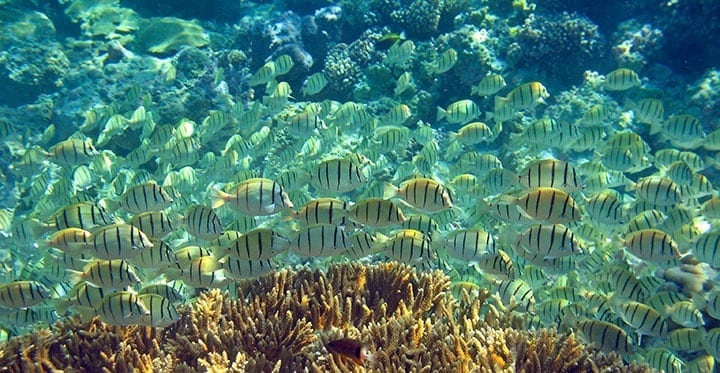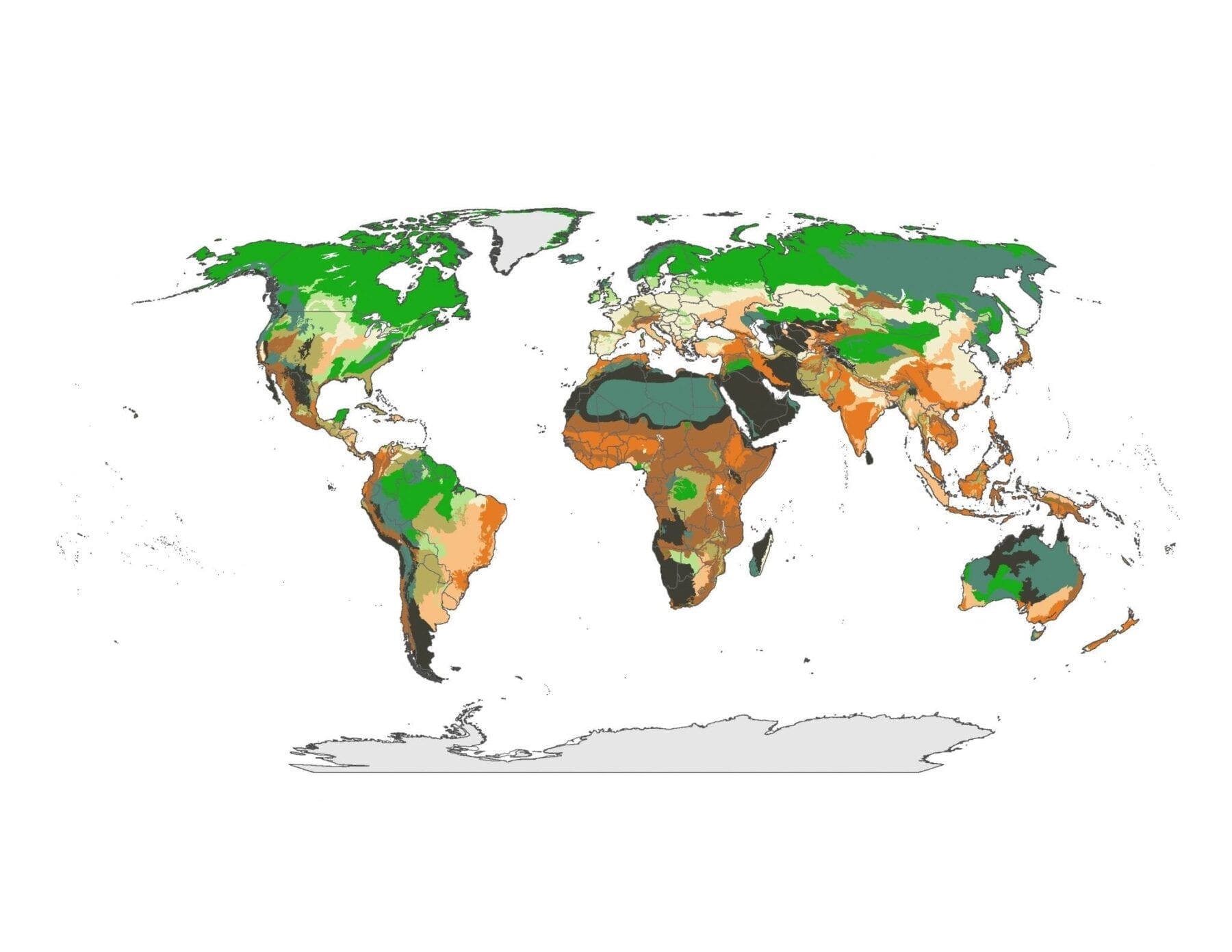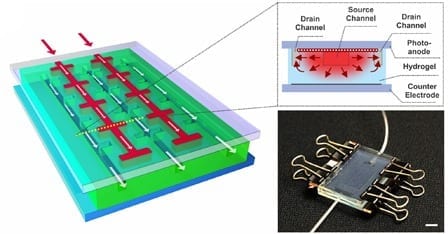
If current climate trends follow historical precedent, ocean ecosystems will be in state of flux for next 10,000 years, according to Scripps Oceanography researchers
If history’s closest analog is any indication, the look of the oceans will change drastically in the future as the coming greenhouse world alters marine food webs and gives certain species advantages over others.
Scripps Institution of Oceanography, UC San Diego, paleobiologist Richard Norris and colleagues show that the ancient greenhouse world had few large reefs, a poorly oxygenated ocean, tropical surface waters like a hot tub, and food webs that did not sustain the abundance of large sharks, whales, seabirds, and seals of the modern ocean. Aspects of this greenhouse ocean could reappear in the future if greenhouse gases continue to rise at current accelerating rates.
The researchers base their projections on what is known about the “greenhouse world” of 50 million years ago when levels of greenhouse gases in the atmosphere were much higher than those that have been present during human history. Their review article appears in an Aug. 2 special edition of the journal Science titled “Natural Systems in Changing Climates.”
For the past million years, atmospheric CO2 concentrations have never exceeded 280 parts per million, but industrialization, forest clearing, agriculture, and other human activities have rapidly increased concentrations of CO2 and other gases known to create a “greenhouse” effect that traps heat in the atmosphere. For several days in May 2013, CO2 levels exceeded 400 parts per million for the first time in human history and that milestone could be left well behind in the next decades. At its current pace, Earth could recreate the CO2 content of the atmosphere in the greenhouse world in just 80 years.
In the greenhouse world, fossils indicate that CO2 concentrations reached 800-1,000 parts per million. Tropical ocean temperatures reached 35º C (95º F), and the polar oceans reached 12°C (53°F)—similar to current ocean temperatures offshore San Francisco. There were no polar ice sheets. Scientists have identified a “reef gap” between 42 and 57 million years ago in which complex coral reefs largely disappeared and the seabed was dominated by piles of pebble-like single-celled organisms called foraminifera.
“The ‘rainforests-of-the-sea’ reefs were replaced by the ‘gravel parking lots’ of the greenhouse world,” said Norris.
The greenhouse world was also marked by differences in the ocean food web with large parts of the tropical and subtropical ocean ecosystems supported by minute picoplankton instead of the larger diatoms typically found in highly productive ecosystems today. Indeed, large marine animals—sharks, tunas, whales, seals, even seabirds—mostly became abundant when algae became large enough to support top predators in the cold oceans of recent geologic times.
“The tiny algae of the greenhouse world were just too small to support big animals,” said Norris. “It’s like trying to keep lions happy on mice instead of antelope; lions can’t get by on only tiny snacks.”
Within the greenhouse world, there were rapid warming events that resemble our projected future. One well-studied event is known as the Paleocene-Eocene Thermal Maximum (PETM) 56 million years ago, which serves as a guide to predicting what may happen under current climate trends.
That event lasted about 200,000 years and warmed the earth by 5-9° C (9-16° F) with massive migrations of animals and plants and shifts in climate zones. Notably, despite the disruption to Earth’s ecosystems, the extinction of species was remarkably light, other than a mass extinction in the rapidly warming deep ocean.
“In many respects the PETM warmed the world more than we project for future climate change, so it should come as some comfort that extinctions were mostly limited to the deep sea,” said Norris. “Unfortunately, the PETM also shows that ecological disruption can last tens of thousands of years.”
The Latest Bing News on:
Marine Food Web
- Invasive lionfish continue conquering global marine ecosystemson April 26, 2024 at 7:58 pm
The Mediterranean Sea, the largest enclosed sea on Earth, is a unique ecosystem that is now threatened by invasive lionfish.
- How A.I. Is Revolutionizing Marine Conservationon April 25, 2024 at 5:00 am
Dyhia Belhabib’s journey to becoming a marine scientist began with war funerals on TV. Her hometown, on the pine-forested slopes of the Atlas Mountains in northern Algeria, lies only 60 miles from the ...
- Which foods have the most plastics? The answer may surprise youon April 22, 2024 at 4:29 pm
AND THAT WOULD HAVE KINOFD REALLY IMPORTANT IMPLICATIONS BOTH FROM OUR OWN HEALTH AS HUMAN CONSUMERS OF SEAOD BUTFO FOR THE HEALTH OF MARINE MAMMALS THAT REALLY PEDEND ON THESE FOOD WEBS. REPORTER: ...
- Marine microbes can tell us about global changes in the oceanon April 21, 2024 at 2:30 pm
Marine microbes are responsible for producing more than half of the Earth's oxygen, making them vital for maintaining the atmospheric balance ...
- Extreme heat in 2023 linked to drastic slump in growth of marine lifeon April 18, 2024 at 10:00 pm
Last year’s marine heatwaves saw an unprecedented decline in the growth of phytoplankton and algae, which many animals in the oceans depend on for food ...
- UCSD gets grant to re-open center to study seafood safetyon April 18, 2024 at 12:51 pm
UC San Diego was awarded $7.35 million for a program to study seafood contaminants and nutrients in a changing climate.
- This 80-foot-long sea monster was the killer whale of its timeon April 17, 2024 at 11:46 am
The discovery of a jawbone fossil suggests that Ichthyotitan severensis may have been the largest ichthyosaur yet known—and hunted prey much like orca.
- Marine plankton behaviour could predict future marine extinctions, study findson April 17, 2024 at 8:03 am
This study has only worked on the planktonic foraminifera, however there are many other microfossil groups which have important roles in marine food webs which need to be studied. They also need ...
- Marine plankton behavior could predict future marine extinctions, study findson April 17, 2024 at 8:00 am
Marine communities migrated to Antarctica during the Earth's warmest period in 66 million years long before a mass-extinction event.
- Neither Plants nor Animals, These Ocean Organisms Protect Their Ecosystems against Heat Waveson April 17, 2024 at 3:45 am
Mixotrophs, which have characteristics of both animals and plants, could help blunt the effects of marine heat waves on ocean ecosystems ...
The Latest Google Headlines on:
Marine Food Web
[google_news title=”” keyword=”Marine Food Web” num_posts=”10″ blurb_length=”0″ show_thumb=”left”]
The Latest Bing News on:
Ocean ecosystems
- Researchers uncover new oceanic locations where microplastics are accumulating: 'Global initiatives are necessary to conserve these rich ecosystems'on April 27, 2024 at 3:15 am
If coral reefs die or dwindle in health, whole ecosystems could be affected. Researchers uncover new oceanic locations where microplastics are accumulating: 'Global initiatives are necessary to ...
- Invasive lionfish continue conquering global marine ecosystemson April 26, 2024 at 7:58 pm
The Mediterranean Sea, the largest enclosed sea on Earth, is a unique ecosystem that is now threatened by invasive lionfish.
- 1 cruise company looks to make a difference preserving marine lifeon April 26, 2024 at 1:45 pm
ABC News’ Ines De La Cuetara reports on one cruise company looking to make a difference by creating a marine reserve to save the ecosystems their industry is often accused of harming.
- Report analyzes sources of ocean plastic pollutionon April 26, 2024 at 8:54 am
The report claims plastic bags are a major ocean pollution issue. They break down into microplastics and/or are ingested by marine life, and it is estimated that 56 percent of all marine life has ...
- Hadley Palmer Advocates for Plastic-Free Oceans at International Summiton April 26, 2024 at 7:25 am
Hadley Palmer’s urgent call to address plastic pollution in oceans resonated at the international summit, urging global leaders to act decisively. Emphasizing data-driven evidence, she advocates for ...
- New NASA satellite monitoring ocean healthon April 26, 2024 at 6:30 am
PACE will reveal how aerosols might fuel phytoplankton growth in the ocean and help identify harmful algal blooms.
- AI-driven Solutions Redefine Marine Conservationon April 25, 2024 at 10:10 am
Dyhia Belhabib, the marine scientist compelled to fight against illegal fishing by her childhood experiences of war and ecosystem collapse ...
- The “Pristine” Marine Ecosystem That Yielded 50 Previously Unknown Specieson April 25, 2024 at 6:25 am
The “Pristine” Marine Ecosystem That Yielded 50 Previously Unknown Species TwistedSifter ...
- Ecosystems are deeply interconnected—environmental research, policy and management should be tooon April 23, 2024 at 9:30 am
Why are we crossing ecological boundaries that affect Earth's fundamental life-supporting capacity? Is it because we don't have enough information about how ecosystems respond to change? Or are we ...
- Opinion: When celebrating Earth Day, don’t forget our coast and the oceanon April 19, 2024 at 1:03 pm
On this Earth Day, we are reminded of the call to action to make a difference and protect, restore and take care of the only home we have. In the words of San Diego’s legendary oceanographer ...
The Latest Google Headlines on:
Ocean ecosystems
[google_news title=”” keyword=”ocean ecosystems” num_posts=”10″ blurb_length=”0″ show_thumb=”left”]










